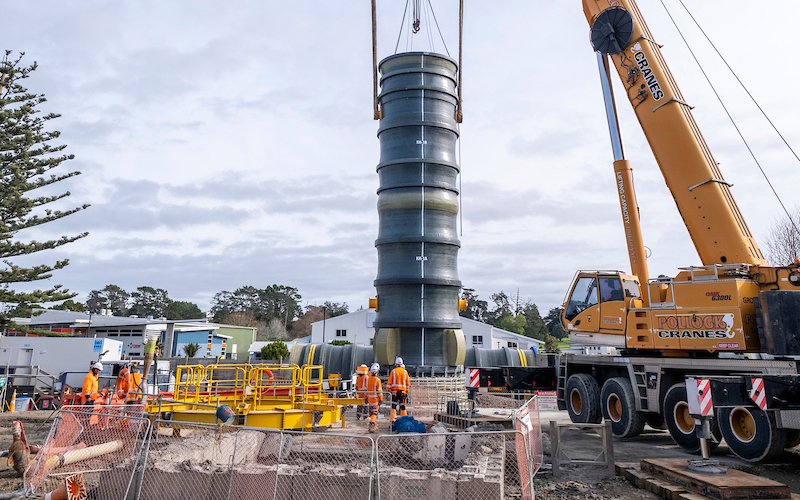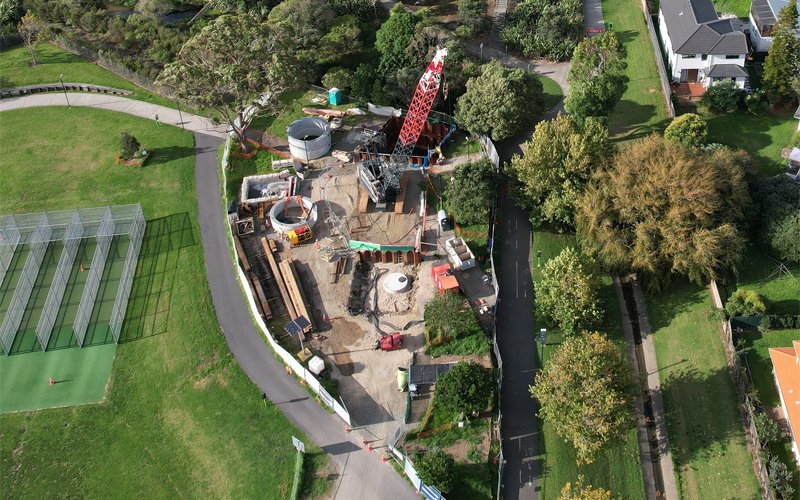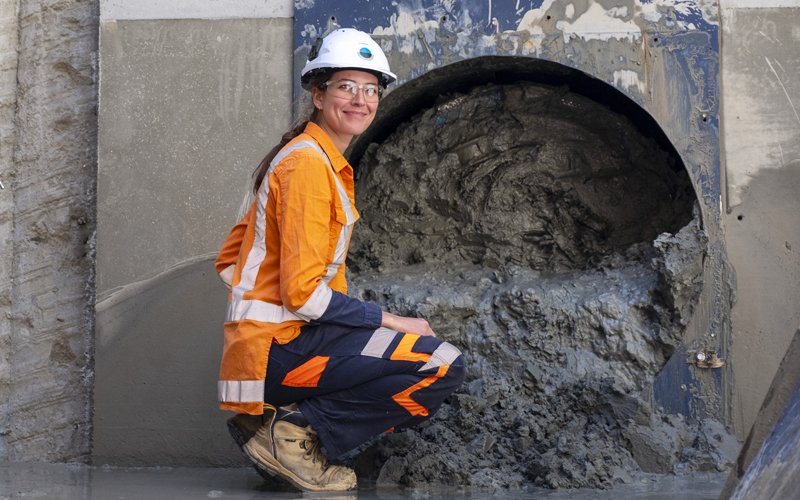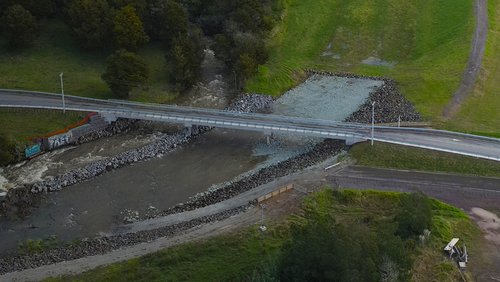30 Jul 2024
The Central Interceptor project – Aotearoa’s largest bored wastewater tunnel – has been designed to improve the health of waterways and meet the demands of ageing infrastructure, population growth and housing intensification in Tāmaki Makaurau Auckland.
“We’re not just building a tunnel; we’re changing a city forever,” says Shayne Cunis FEngNZ, Watercare Central Interceptor Executive Programme Director.
Ageing infrastructure coupled with increasing demands necessitated a visionary solution. The main tunnel and network of smaller tunnels significantly reduces wet weather overflows into Central Auckland waterways and beaches, leading to an improvement in regional water quality. It also provides resilience for ageing assets and ensures sufficient capacity for Auckland’s wastewater, given the city’s projected population growth and intensification.
“We’re fixing 150 years of environmental issues, future-proofing the infrastructure for our children and grandchildren, and doing so safely while engaging with our stakeholders and local communities,” says Shayne.
Planning and concept design for the tunnel (running between Pt Erin, Herne Bay and the Māngere Wastewater Treatment Plant) began in 2009. In 2019, Watercare awarded the construction contract to Ghella Abergeldie JV. Work began in 2019 and is due for completion by early 2026. This year Watercare expects completion of sites at Blockhouse Bay, Lynfield and Avondale, with section one of the southern tunnel (May Road, Mt Roskill south) going live by the end of the year.
While the main tunnel (and its state-of-the-art tunnel boring machine (TBM) Hiwa-i-te-Rangi) receives plenty of interest, there has also been some innovative engineering work underway at one of Auckland’s busiest hubs for sport and recreation, Keith Hay Park. Situated next to State Highway 20 in Mt Roskill, it has remained open to the public and sports clubs despite the Central Interceptor site occupying a large section of the park.

Fibreglass reinforced polymer shaft liner being lifted into place at Keith Hay Park. Photo: Watercare
Shayne explains that wastewater creates a corrosive environment that eats away at the concrete.
“So in the design stage we looked at various strategies to achieve this tunnel’s design life, from sacrificial concrete to acid-resistant concrete,” he says.
“We came across these innovative Australian-designed fibreglass-reinforced polymer (FRP) shafts, whereby the material is impermeable to the corrosive environment.”
These shafts allow wastewater from the shallow existing sewer pipes (typically a couple of metres underground) to reach the main tunnel 78m below. The challenge of digging and installing these shafts lay in the fact that they are made up of very large pieces (12m long, 5.5m in diameter and 25 tonnes) and had to be shipped from manufacturers in Indonesia and Australia.
We’re fixing 150 years of environmental issues, future-proofing the infrastructure for our children and grandchildren, and doing so safely while engaging with our stakeholders and local communities.
“The FRP shafts consist of a series of cascade shelves, which creates a series of cascading mini waterfalls, rather than a 78m single waterfall,” says Chris McCarthny CPEng, Watercare Central Interceptor Delivery Manager. Chris adds: “This is really important as it takes the energy out of the falling wastewater and stops the tunnel from being battered and eroded. It also helps reduce the aeration of the wastewater, which reduces the release of harmful gases,”
Although cascades aren’t new technology, the large scale is what makes these different.
“There was no rule book for how to do this at scale,” says Chris. “So, there was ingenuity in not only the way we did the digging, but also in how we got the dirt out.”
He continues: “First we drilled a 76-metre-deep pilot hole, 0.9m in diameter, which we 3D- scanned to make sure we were completely vertical.

Directional drilling under SH20. Photo: Watercare
“Then we drilled five holes approximately 1.5m deep and used a custom-made 4.2m diameter flat reaming tool that was centralised by the pilot hole, to scrape the rock into five 1.2m diameter holes.
“Once the holes were filled with rocks, we picked them up using a traditional auger bucket. We repeated this process under bentonite support fluid until we reached a final depth of 76m, and all without a single person going below the ground surface,” says Chris.
“The next challenge was installing all of the 25-tonne FRP modules with tight clearances and strict verticality requirements. This was done by filling each of the FRP modules with a predetermined volume of water to take advantage of the natural buoyancy of the modules in the bentonite support fluid, slowly sinking each module, bolting on the next one, and repeating the process until all of them were in the ground, then carefully grouting them in place bottom up after a final 3D scan to confirm we had met the 1 in 300 verticality requirement.”
Engineering teams are also connecting the main Central Interceptor tunnel to the local wastewater network. Victoria, a “nano” micro TBM, is creating two new sewer lines (Branch 9B Diversion and Collector Sewer 9).
Putting in new connections also involved directional pilot drilling underneath the motorway and dodging buried trees in a former swamp.
“We had a couple of goes to complete the drilling and it was hair-raising stuff, tunnelling under the motorway, but it was successful and a big one to tick off the list,” says Chris.
Both Shayne and Chris acknowledge the power of the teams involved in executing this large-scale, complex project.
“I’ve worked on a lot of projects, and this one has certainly shown the benefits of investing in the basics – consulting with stakeholders, caring for the environment and caring for the people,” Chris says, while Shayne recognises the rarity of such a vast project on home turf: “It’s not often you get to work on such a multi-dimensional project. We really are building a better future for Aucklanders and New Zealand.”
Staff spotlight
Emma Hyde, Ghella Abergeldie JV Site Engineer, Shafts and Microtunnels, graduated from Te Herenga Waka Victoria University of Wellington at the start of 2019 with a double major degree in Building Science, Project Management and Sustainable Engineering Systems. She joined the Central Interceptor project in May 2019, initially in a risk management role, then as a Quality Engineer, before reaching her goal of being a Site Engineer. “I knew from primary school that I wanted to be in construction,” she says. “I come from a long line of civil engineers… and I enjoy the problem-solving and the sequencing of works – you have to think 100 steps ahead here.”

Emma Hyde, Ghella Abergeldie JV Site Engineer, Shafts and Microtunnels. Photo: Watercare
Emma works with Victoria, the “nano” micro TBM (925 mm diameter), designed to connect the main Central Interceptor tunnel to the local wastewater network. This new infrastructure will improve water quality in tributaries to Oakley Creek as well as allowing for future Kāinga Ora housing developments in the area.
This article was first published in the June 2024 issue of EG magazine.




